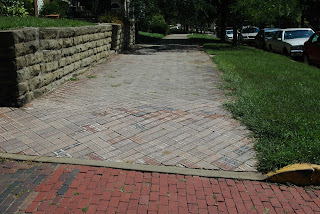 |
| Brick street in Harmar, Ohio |
In a pair of
recent posts, I offered perspectives on pedestrian safety. I wrote first about how the education of drivers isn’t an adequate strategy
relative to the high compliance needed for pedestrian safety. Later, I suggested that the best strategies
for pedestrian safety may fall outside the Overton Window for acceptable
public discourse.
Although pedestrian safety is never far from
the mind of an urbanist, I’ll leave the subject behind for awhile after today,
but not before making a couple of final points.
The first
point is a distressing perspective on pedestrian safety from a recent story out of New York City. Some of the details remain unclear, such as
whether the police car turn indicator was flashing, whether the officer was talking
on a cell phone, and whether the pedestrian was distracted by his own phone,
but the facts, and the video, are still startling.
A police
officer was stopped at a traffic signal.
Despite the clear visibility of a pedestrian on a far corner, the
officer began a left turn upon the signal turning green, striking and killing
the pedestrian who was walking with the green light. And in the court documents submitted in
response to the resulting civil suit, the NYPD legal staff made this argument, “Plaintiff’s
implied assumption of risk caused or contributed, in whole or in part, to his
injuries.”
Really? Walking on a sunny day in a well-marked
crosswalk with a green light is considered to be an “implied assumption of risk”?
Admittedly, it
would have been unwise if the victim was being distracted by a cell phone because
pedestrians should remain alert to risks.
But describing a pedestrian in full compliance with traffic laws as having
“assumed risk” is poor public policy. And
I doubt a car passenger, injured through a mistake by the driver in another car,
would be described as having made an “implied assumption of risk.”
I’m suspect
that the NYPD legal staff has no real hope of exonerating the officer from her
mistake and was only blaming the victim in hopes of reducing the monetary
damages. But this is a case where blaming
the victim sends a public message that is both tone-deaf and contrary to the
public interest.
As long as
we try to define walking in a crosswalk as an inherently dangerous act, we’ll
never make progress with pedestrian safety.
Moving
onward, one of my earlier posts, in which I wrote about slowing traffic through
lane widths and/or strategic location of parking, elicited a question about alternative
traffic calming devices such as speed bumps or rumble strips. It was a question worthy of a response, which
I’ll try to provide here.
There can be
places for these other types of traffic calming approaches, which are generally
described as vertical traffic calming compared to the horizontal traffic
calming of lane widths and parking placement.
Personally, I think a well-situated speed table, which is an extended area
of raised pavement, can be effective in particular settings, such an intersection
where pedestrians are the dominant mode or for pedestrian routes to a shopping
center storefront.
But speed
tables are an exception. And most other
vertical traffic calming measures, such as speed bumps, are never even offered
for public consideration because emergency services departments oppose them as
potentially slowing emergency response times.
Personally, I don’t think that assigning infinite weight to one
variable, in this case emergency response times, is the right way to build a balanced,
well-functioning city, but that’s a discussion for another day.
Even if we
set aside the emergency response issue, I think the value of most vertical
traffic calming measures is limited.
Rumble strips and speed bumps, much like stop signs, seem often to induce
drivers to speed up between installations to make up for lost time.
I spent a
recent weekend with a sister and brother-in-law who live in a subdivision protected
by steep speed bumps, bumps that if I encounter at a speed above 2 mph will whack
my oil pan. I often note drivers
speeding up between bumps in irritation at the time they’re spending traversing
the bumps. I pity pedestrians trying to
cross the minefield of drivers distracted by simultaneously trying to travel
quickly and to protect their undercarriages.
So I’m mostly
dubious about vertical traffic calming measures of limited width. But there are other options. A regular reader who lives in a neighborhood with
disintegrating pavement has told me, with an apparent straight face, that she
has no problem with potholes because they provide traffic calming.
 |
| Brick ADA ramp to a brick street in Marietta, Ohio |
If waiting
for potholes to provide traffic calming seems too passive, David Levinson writing
in Streets MN argues that alternative surfaces such as brick can
provide traffic calming and a more distinctive streetscape. However, bricks, and their counterparts in
much of the country, cobblestones, are more expensive to install and to
maintain than asphalt and also result in more tire noise.
At the
bottom line, with the sole exception of speed tables in a few preferred locations,
emergency services opposition, driver response, cost, and tire noise undermine every
known vertical traffic calming measure. The
horizontal traffic calming measures of lane widths and parking placement remain
the preferred alternatives, at least to my sensibilities.
And even
those don’t help when a distracted police officer kills a pedestrian with the
right-of-way and the police department tries to blame the pedestrian.
When I next
write, I’ll finally circle back to the topic of affordable housing and
urbanism. I’m far from an expert on the
subject, and fear that expertise is what is needed, but will share what I know
and what I believe.
As always,
your questions or comments will be appreciated.
Please comment below or email me.
And thanks for reading. - Dave Alden (davealden53@comcast.net)
No comments:
Post a Comment